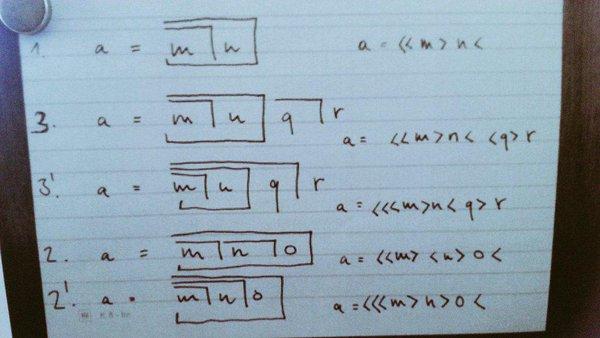Operator Variables in Logical Graphs • Discussion 2
• https://inquiryintoinquiry.com/2024/04/09/operator-variables-in-logical-graphs-discussion-2/
Re: Operator Variables in Logical Graphs • 1
• https://inquiryintoinquiry.com/2024/04/06/operator-variables-in-logical-graphs-1/
Re: Cybernetics List • Lou Kauffman
• https://groups.google.com/g/cybcom/c/XKT76QI_OnI/m/3u9P2Ir5AgAJ
LK:
❝I am writing to comment that there are some quite interesting situations that generalize the DeMorgan Duality.
❝One well-known one is this. Let R* denote the real numbers with a formal symbol @, denoting infinity, adjoined so that:
• @ + @ = @
• @ + 0 = @
• @ + x = @ when x is an ordinary real number
• 1 ÷ @ = 0
❝(Of course you cannot do anything with @ or the system collapses. One can easily give the constraints.)
❝Define ¬x = 1/x.
• x + y = usual sum otherwise.
❝Define x ∗ y = xy/(x + y) = 1/((1/x) + (1/y)).
❝Then we have x ∗ y = ¬(¬x + ¬y), so that the system (R*, ¬, +, ∗) satisfies DeMorgan duality and it is a Boolean algebra when restricted to {0, @}.
❝Note also that ¬ fixes 1 and -1. This algebraic system occurs of course in electrical calculations and also in the properties of tangles in knot theory, as you can read in the last part of my included paper “Knot Logic”. I expect there is quite a bit more about this kind of duality in various (categorical) places.❞
Thanks, Lou, there's a lot to think about here, so I'll need to study it a while. Just off hand, the embedding into reals brings up a vague memory of the very curious way Peirce defines negation in his 1870 “Logic of Relatives”. I seem to recall it involving a power series, but it's been a while so I'll have to look it up again.
#Peirce #Logic #LogicalGraphs #EntitativeGraphs #ExistentialGraphs
#SpencerBrown #LawsOfForm #BooleanFunctions #PropositionalCalculus
